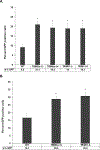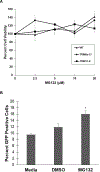Knockdown of TRIM5α or TRIM11 increases lentiviral vector transduction efficiency of human Muller cells
- PMID: 33440192
- PMCID: PMC7946771
- DOI: 10.1016/j.exer.2021.108436
Knockdown of TRIM5α or TRIM11 increases lentiviral vector transduction efficiency of human Muller cells
Abstract
The goal of this study was to determine the expression and distribution of the host restriction factors (RFs) TRIM5α and TRIM11 in non-human primate (NHP) neural retina tissue and the human Muller cell line MIO-M1. In addition, experiments were performed to determine the effect of TRIM5α and TRIM11 knockdown on FIVGFP transduction of MIO-M1 cells with the goal of devising strategies to increase the efficiency of lentiviral (LV) gene delivery. Immunofluorescence (IF) studies indicated that TRIM5α and TRIM11 were localized predominantly in nuclei within the outer nuclear layer (ONL) and inner nuclear layer (INL) of NHP retina tissue. Double label IF indicated that TRIM5α and TRIM11 were localized to some of the retinal Muller cell nuclei. MIO-M1 cells expressed TRIM5α predominantly in the nucleus and TRIM11 primarily in the cytosol. FIVGFP transduction efficiency was significantly increased, at 4 and 7 days post transduction, in TRIM5α and TRIM11 knockdown clones (KD) compared to WT MIO-M1 cells. In addition, pretreatment with the proteasome inhibitor MG132 increased the transduction efficiency of FIVGFP in WT MIO-M1 cells. The nuclear translocation of NF-κB (p65), at 72 h post FIVGFP transduction, was enhanced in TRIM5α and TRIM11 KD clones. The expression of TRIM5α and TRIM11 in macaque neural retina tissue and MIO-M1 cells indicate the presence of these RFs in NHP retina and human Muller cells. Our data indicate that even partial knockdown of TRIM5α or TRIM11, or a short proteasome inhibitor pretreatment, can increase the transduction efficiency of a LV vector.
Keywords: Gene therapy; Muller cells; Proteasome inhibitor; Retina; TRIM11; TRIM5α; Viral vectors.
Copyright © 2021 Elsevier Ltd. All rights reserved.
Figures







Similar articles
-
The RLR intrinsic antiviral system is expressed in neural retina and restricts lentiviral transduction of human Mueller cells.Exp Eye Res. 2023 Nov;236:109647. doi: 10.1016/j.exer.2023.109647. Epub 2023 Sep 7. Exp Eye Res. 2023. PMID: 37689341 Free PMC article.
-
TRIM5α variations influence transduction efficiency with lentiviral vectors in both human and rhesus CD34(+) cells in vitro and in vivo.Mol Ther. 2014 Feb;22(2):348-358. doi: 10.1038/mt.2013.256. Epub 2013 Oct 23. Mol Ther. 2014. PMID: 24153115 Free PMC article.
-
Efficient transduction of human hematopoietic repopulating cells with a chimeric HIV1-based vector including SIV capsid.Exp Hematol. 2013 Sep;41(9):779-788.e1. doi: 10.1016/j.exphem.2013.04.014. Epub 2013 May 9. Exp Hematol. 2013. PMID: 23665451 Free PMC article. Clinical Trial.
-
Human TRIM5α: Autophagy Connects Cell-Intrinsic HIV-1 Restriction and Innate Immune Sensor Functioning.Viruses. 2021 Feb 19;13(2):320. doi: 10.3390/v13020320. Viruses. 2021. PMID: 33669846 Free PMC article. Review.
-
TRIM11 promotes lymphomas by activating the β-catenin signaling and Axin1 ubiquitination degradation.Exp Cell Res. 2020 Feb 15;387(2):111750. doi: 10.1016/j.yexcr.2019.111750. Epub 2019 Nov 28. Exp Cell Res. 2020. PMID: 31786079 Review.
Cited by
-
AAV2.7m8 transduction of stage 2 human retinal organoids induces highly variable responses in innate and inflammatory gene expression and cytokine secretion.Exp Eye Res. 2025 Sep;258:110478. doi: 10.1016/j.exer.2025.110478. Epub 2025 Jun 6. Exp Eye Res. 2025. PMID: 40484363
-
The RLR intrinsic antiviral system is expressed in neural retina and restricts lentiviral transduction of human Mueller cells.Exp Eye Res. 2023 Nov;236:109647. doi: 10.1016/j.exer.2023.109647. Epub 2023 Sep 7. Exp Eye Res. 2023. PMID: 37689341 Free PMC article.
-
Immunoglobulin heavy constant gamma 1 silencing decreases tonicity-responsive enhancer-binding protein expression to alleviate diabetic nephropathy.J Diabetes Investig. 2024 May;15(5):572-583. doi: 10.1111/jdi.14144. Epub 2024 Jan 24. J Diabetes Investig. 2024. PMID: 38268239 Free PMC article.
References
-
- Aktas Z, Rao H, Slauson SR, Gabelt BT, Larsen IV, Sheridan RTC, Herrnberger L, Tamm ER, Kaufman PL, Brandt CR: Proteasome inhibition increases the efficiency of lentiviral vector-mediated transduction of trabecular meshwork. Invest. Ophthalmol. Vis. Sci, 59 (2018), pp. 298–310, 10.1167/iovs.17-22074. - DOI - PMC - PubMed
Publication types
MeSH terms
Substances
Grants and funding
LinkOut - more resources
Full Text Sources
Other Literature Sources
Miscellaneous

